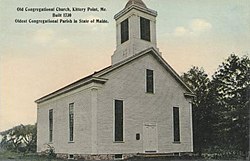First Congregational Church and Parsonage (Kittery, Maine)
The First Congregational Church and Parsonage is a historic church complex at 23 Pepperrell Road (Maine State Route 103) in the Kittery Point section of Kittery, Maine. Built in 1730 for a congregation first organized in 1653, the church is the oldest in Kittery, and one of the oldest in the state of Maine. It is accompanied by a parsonage house, built in 1729, and a small cemetery, established in 1733. The buildings were listed on the National Register of Historic Places in 1978; the cemetery was added to the listing in 1997.[1]
First Congregational Church and Parsonage | |
 Postcard view of church, c. 1912 | |
| Location | 23 Pepperrell Rd., Kittery Point, Maine |
|---|---|
| Coordinates | 43°4′54″N 70°42′56″W / 43.08167°N 70.71556°W |
| Area | 2 acres (0.81 ha) (original); 1 acre (0.40 ha) (increase) |
| Built | 1729 and 1733 |
| Architectural style | Greek Revival, Colonial |
| NRHP reference No. | 78000333 (original) 97000602[1] (increase) |
| Significant dates | |
| Added to NRHP | December 18, 1978 |
| Boundary increase | July 03, 1997 |
Description and history
editThe First Congregational Church in Kittery was organized in 1653. In 1729 this congregation elected to build a new parsonage. Although completed the same year, the adjacent 1728 church building burned down, and the present church building was constructed the following year.[2] It was built with the support of merchant William Pepperrell, Sr., the father of French and Indian War hero, William Pepperrell, also an active member of the congregation.[citation needed] In 1733 the parish established a burial ground south of church (across Pepperrell Road), which is now the burial site of many of the town's leading citizens. A new parsonage was built in 1910, between the old one and the church.[2] Nearby is the Lady Pepperrell House, built in 1760.
The church is a modest rectangular wood-frame structure, now facing south, with a gable roof and a small tower. The three-bay main facade has the main entrance at its center, with tall windows in the outer bays, and a smaller sash window above the entrance in the gable. Greek Revival paneled pilasters are found at the building corners. The square tower has a short first stage, topped by a belfry with louvered openings and pilasters. The tower is capped by a segmented dome. The building has seen numerous alterations, and most of its decorative elements are the result of Greek Revival renovations in 1840. The building interior retains its original two-aisle layout and its pulpit. The building was moved a short distance to its present site and orientation in 1872.[2]
The old parsonage is a 2+1⁄2-story wood-frame building, with a five-bay facade facing south, and a long five-bay two-story ell extending to the rear, facing the road to the west. In 1958 a second ell was added to the north side. After the new parsonage was built in 1910, this building was used as a community center.[2]
The cemetery is about 1 acre (0.40 ha) in size, and is bounded on three sides by a low stone wall, believed to date to 1733, and on the fourth by the Piscataqua River. An iron gate, mounted on concrete posts with round-arch panels and finials, was added to the north entrance in 1910. Burials in the cemetery date from the mid-18th to mid-20th centuries. The most prominent marker is dedicated to the crew of the Hattie Eaton, lost at sea with all hands in 1876.[3]
Notable members
edit- William Pepperrell, Baronet, judge, military leader
- William Whipple, signer of the United States Declaration of Independence[2]
See also
editReferences
edit- ^ a b "National Register Information System". National Register of Historic Places. National Park Service. April 15, 2008.
- ^ a b c d e "NRHP nomination for First Congregational Church and Parsonage (original)". National Park Service. Retrieved June 9, 2015.
- ^ "NRHP nomination for First Congregational Church and Parsonage (1997 increase)". National Park Service. Retrieved June 9, 2015.

